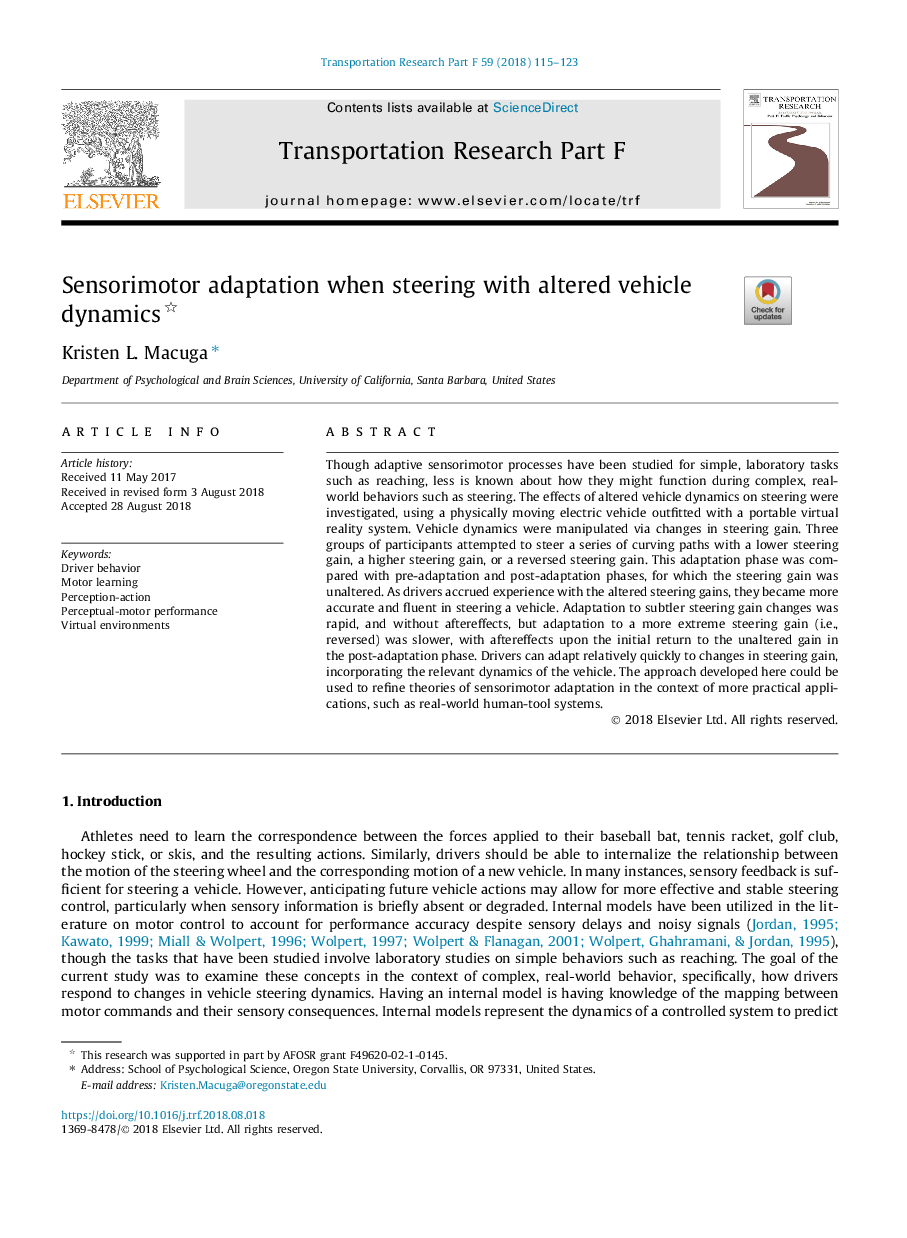| کد مقاله | کد نشریه | سال انتشار | مقاله انگلیسی | نسخه تمام متن |
|---|---|---|---|---|
| 10134402 | 1645613 | 2018 | 9 صفحه PDF | دانلود رایگان |
عنوان انگلیسی مقاله ISI
Sensorimotor adaptation when steering with altered vehicle dynamics
ترجمه فارسی عنوان
انطباق سنسور حرکتی هنگامی که فرمان با تغییر دینامیک خودرو
دانلود مقاله + سفارش ترجمه
دانلود مقاله ISI انگلیسی
رایگان برای ایرانیان
کلمات کلیدی
رفتار راننده، یادگیری موتور، ادراک-عمل، عملکرد تصور-موتور محیط های مجازی،
ترجمه چکیده
اگر چه فرآیندهای سنسورهای تطبیقی برای انجام کارهای ساده و آزمایشگاهی مانند رسیدن به اهداف مورد بررسی قرار گرفته است، در مورد چگونگی عملکرد آنها در طول رفتار پیچیده و دنیای واقعی مانند فرمان شناخته شده کمتر مورد مطالعه قرار گرفته است. اثرات تغییرات دینامیک خودرو بر فرماندهی، با استفاده از وسیله نقلیه الکتریکی جابجایی فیزیکی که با یک سیستم واقعیت مجازی قابل حمل، مورد بررسی قرار گرفت، مورد بررسی قرار گرفت. دینامیک خودرو با تغییر در افزایش فرمان دستکاری شد. سه گروه از شرکت کنندگان تلاش کردند تا یک سری مسیرهای انحرافی را با کم شدن سرعت فرمان، افزایش فرمان یا افزایش فرمان برگشتی، هدایت کنند. این فاز انطباق با مراحل پیش سازگاری و پس از انطباق مقایسه شد، که افزایش فرمان آن تغییر نیافت. در حالیکه رانندگان تجربه با دستاوردهای فرمان تغییر یافته را تجربه کردند، در کنترل وسیله نقلیه دقیق تر و روان تر شدند. سازگاری با تغییرات فرماندهی دقیق تر سریع شد و بدون تأثیرات، اما سازگاری با افزایش فرکانس شدید (یعنی معکوس شدن) کندتر بود، با تأثیرات پس از بازگشت اولیه به افزایش غیرمستقیم در مرحله پس از انطباق. رانندگان می توانند نسبتا سریع به تغییرات در افزایش فرمان، با ترکیب پویایی وسایل نقلیه سازگار شوند. رویکرد توسعه یافته در اینجا می تواند مورد استفاده قرار گیرد تا نظریه های تطبیق حسگر های حرکتی را در زمینه برنامه های کاربردی کاربردی تر مانند سیستم های ابزار انسانی واقعی واقع شود.
موضوعات مرتبط
علوم انسانی و اجتماعی
روانشناسی
روان شناسی کاربردی
چکیده انگلیسی
Though adaptive sensorimotor processes have been studied for simple, laboratory tasks such as reaching, less is known about how they might function during complex, real-world behaviors such as steering. The effects of altered vehicle dynamics on steering were investigated, using a physically moving electric vehicle outfitted with a portable virtual reality system. Vehicle dynamics were manipulated via changes in steering gain. Three groups of participants attempted to steer a series of curving paths with a lower steering gain, a higher steering gain, or a reversed steering gain. This adaptation phase was compared with pre-adaptation and post-adaptation phases, for which the steering gain was unaltered. As drivers accrued experience with the altered steering gains, they became more accurate and fluent in steering a vehicle. Adaptation to subtler steering gain changes was rapid, and without aftereffects, but adaptation to a more extreme steering gain (i.e., reversed) was slower, with aftereffects upon the initial return to the unaltered gain in the post-adaptation phase. Drivers can adapt relatively quickly to changes in steering gain, incorporating the relevant dynamics of the vehicle. The approach developed here could be used to refine theories of sensorimotor adaptation in the context of more practical applications, such as real-world human-tool systems.
ناشر
Database: Elsevier - ScienceDirect (ساینس دایرکت)
Journal: Transportation Research Part F: Traffic Psychology and Behaviour - Volume 59, Part A, November 2018, Pages 115-123
Journal: Transportation Research Part F: Traffic Psychology and Behaviour - Volume 59, Part A, November 2018, Pages 115-123
نویسندگان
Kristen L. Macuga,
